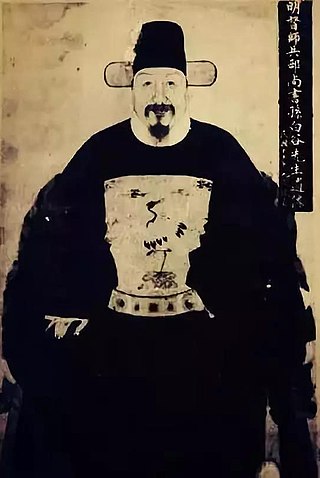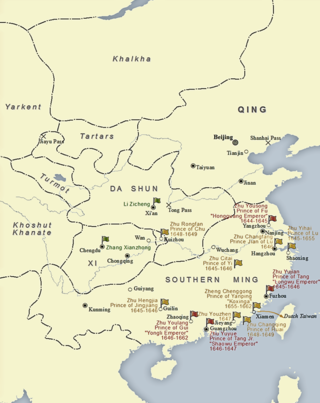Related Research Articles

Li Zicheng, born Li Hongji, also known by the nickname, Dashing King, was a Chinese peasant rebel leader who overthrew the Ming dynasty in April 1644 and ruled over northern China briefly as the Yongchang Emperor of the short-lived Shun dynasty before his death a year later.

Wu Sangui, courtesy name Changbai (長白) or Changbo (長伯), was a notorious Ming dynasty military officer who played a key role in the fall of the Ming dynasty and the founding of the Qing dynasty in China. In Chinese folklore, Wu Sangui is regarded as a disreputable Han Chinese traitor who played a pivotal role in several historical events, including the Battle of Shanhai Pass, Qing conquest of Ming China, the suppression of Southern Ming resistances and the execution of the Yongli Emperor, and eventually double-crossed both of his masters, the Ming and the Qing dynasties.

The Chongzhen Emperor, personal name Zhu Youjian, courtesy name Deyue (德約), was the 17th and last emperor of the Ming dynasty. He reigned from 1627 to 1644. "Chongzhen", the era name of his reign, means "honorable and auspicious."
The Seven Grievances was a manifesto announced by Nurhaci, khan of the Later Jin, on the thirteenth day of the fourth lunar month in the third year of the Tianming era of his reign; 7 May 1618. It effectively declared war against the Ming dynasty.

Shi Kefa, courtesy names Xianzhi and Daolin, was a government official and calligrapher who lived in the late Ming dynasty. He was born in Xiangfu and claimed ancestry from Daxing County, Shuntian Prefecture. He was mentored by Zuo Guangdou (左光斗). He served as the Minister of War in Nanjing during the early part of his career. He is best remembered for his defence of Yangzhou from the Qing dynasty and was killed when Yangzhou fell to Qing forces in April 1645. After his death, the Southern Ming granted him the posthumous name "Zhongjing". Nearly a century later, the Qianlong Emperor of Qing granted Shi Kefa another posthumous name, "Zhongzheng" His descendants collected his works and compiled them into a book titled Lord Shi Zhongzheng's Collections (史忠正公集).

The Battle of Shanhai Pass, fought on May 27, 1644 at Shanhai Pass at the eastern end of the Great Wall, was a decisive battle leading to the beginning of the Qing dynasty rule in China proper. There, the Qing prince-regent Dorgon allied with former Ming general Wu Sangui to defeat rebel leader Li Zicheng of the Shun dynasty, allowing Dorgon and the Qing army to rapidly conquer Beijing.

The Shun dynasty, officially the Great Shun, also known as Li Shun, was a short-lived Chinese dynasty that existed during the Ming–Qing transition. The dynasty was founded in Xi'an on 8 February 1644, the first day of the lunar year, by Li Zicheng, the leader of a large peasant rebellion, by proclaiming himself "emperor" (皇帝) instead of the title "king" (王) before founding the dynasty.
The 1642 Yellow River flood or Kaifeng flood was a man-made disaster in October, 1642, that principally affected Kaifeng and Xuzhou.
Gao Guiying was a female Chinese rebellion leader and military commander of the short-lived Shun dynasty. She was the empress of the Shun founding emperor Li Zicheng.

Sun Chuanting, courtesy name Boya (百雅), art name Baigu (白谷), was born in Shanxi; he was the late Ming dynasty's Minister of War, and Field Marshal (Dushi). He led 10,000 Ming troops against Li Zicheng's 70,000 troops. He was defeated and killed by Li in the Battle of Tongguan (1643).

The Jiashen Incident, also known as the Battle of Beijing, took place in 1644 in the areas surrounding Beijing, and was fought between forces of the incumbent Ming dynasty and the Shun dynasty founded by peasant rebel leader Li Zicheng. It eventually resulted in the collapse of the Ming dynasty. Remnants of the Ming imperial family, whose regime is known as the Southern Ming dynasty in historiography, would continue to rule parts of southern China until 1662.

The Affaire in the Swing Age, also known as The Dynasty or Love Against Kingship, is a 2003 Chinese television series based on the novel Jiangshan Fengyu Qing by Zhu Sujin, who was also the screenwriter for the series. The series depicts the events in the transition of the Ming dynasty to the Qing dynasty in China, focusing on the lives of historical figures such as Li Zicheng, Wu Sangui, Chen Yuanyuan, the Chongzhen Emperor and Huangtaiji.
Chen Mingxia was Grand Secretariat and President of Ministry Personnel of the Qing dynasty. He was from Liyang in Jiangsu and was a Chinese official during the Shunzhi period (1644–1661) of the Qing dynasty (1644–1912). Before joining the Qing in early 1645, he had successively served the Ming dynasty (1368–1644) and the short-lived Shun regime of rebel leader Li Zicheng (1602–1645). He then served in the highest ranks of the Qing bureaucracy, being promoted to Grand Secretariat of the empire.

The transition from Ming to Qing or the Manchu conquest of China from 1618 to 1683 saw the transition between two major dynasties in Chinese history. It was a decades-long conflict between the emerging Qing dynasty, the incumbent Ming dynasty, and several smaller factions. It ended with the consolidation of Qing rule, and the fall of the Ming and several other factions.

The Later Jin, officially known as Jin or the Great Jin, was a Jurchen-led royal dynasty of China in Manchuria and the precursor to the Qing dynasty. Established in 1616 by the Jianzhou Jurchen chieftain Nurhaci upon his reunification of the Jurchen tribes, its name was derived from the earlier Jin dynasty founded by the Wanyan clan which had ruled northern China in the 12th and 13th centuries.

Events from the year 1644 in China.

The late Ming peasant rebellions were a series of peasant revolts during the last decades of the Ming dynasty lasting from 1628–1644. They were primarily caused by natural disasters in Shaanxi, Shanxi, and Henan. At the same time, the She-An Rebellion and Later Jin incursions forced the Ming government to cut funding for the postal service, which resulted in the mass unemployment of men in the provinces hit hard by natural disasters. Unable to cope with three major crises at the same time, the Ming dynasty collapsed in 1644.

The Great Plague in the late Ming dynasty, also known as the North China Plague in the late Ming dynasty, or the Great Plague of Jingshi, was a major plague epidemic between 1633 and 1644, the last phase of the Ming dynasty in China, during the Chongzhen Emperor's reign (1627–1644). The epidemic started in Shanxi Province in 1633, and reached Beijing in 1641, where the plague caused the deaths of more than 200,000 people in 1643, directly contributing to the collapse of the Ming dynasty in 1644.
Zhu Cilang was a crown prince of the Ming dynasty. He was the eldest son of the Chongzhen Emperor and Lady Zhou, Empress Xiaojielie, and he was made the crown prince in 1630.
References
- 1 2 Forges, Roger V. Des (2020-03-09). The Mythistorical Chinese Scholar-Rebel-Advisor Li Yan: A Global Perspective, 1606-2018. BRILL. pp. 187–195. ISBN 978-90-04-42106-6.